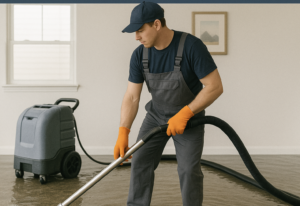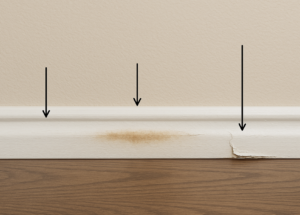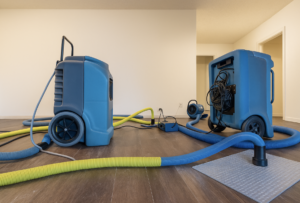Water damage is a common and costly problem that affects both homeowners and businesses. It can come from a small leak or a big natural event, but either way, water can quickly cause serious harm to a building’s structure and belongings. The important thing to know is that water damage isn’t always the same. Distinguishing between typical water damage and flood damage is crucial for preventing further issues, acting quickly, and ensuring your insurance will cover the repairs.
Water damage results from inside the property — things like broken pipes, leaking appliances, or plumbing issues. Flood damage, on the other hand, comes from outside sources like heavy storms, flash floods, or overflowing rivers. Understanding these differences helps property owners better assess their risks and choose the most effective restoration solutions.
Definition and Causes
What is Water Damage?
Water damage usually happens from stuff inside your home or business — like a pipe that bursts, a washing machine that leaks, or maybe a slow roof drip you didn’t notice. It often messes up your walls, floors, ceilings, and personal things. The good part is, this water is usually pretty clean or just a little dirty, so if you catch it early, fixing it won’t be too hard or expensive.
What is Flood Damage?
Flood damage is different — it’s when water comes from outside, like after a heavy rain, a river flooding, or a big storm. Floodwater is usually dirty and full of nasty stuff like sewage and chemicals, which makes cleanup tougher and even dangerous. Floods can cause damage all over your property — basements, foundations, yards, even whole neighborhoods.
Why Does It Matter?
Knowing the difference is really important because water damage and flood damage need different ways to fix them. Plus, insurance companies treat them differently too. My advice? If you see water damage inside your home, don’t wait — call someone to help. But if you’ve got flood damage, it’s best to call the pros who know how to deal with all the mess safely.
Key Differences
Understanding the key differences between water damage and flood damage is crucial for effective response and restoration. One of the primary distinctions lies in the source of the water. Water damage typically originates from internal sources, such as leaking or burst pipes, faulty appliances, or plumbing issues within the building. In contrast, flood damage is caused by external sources, including natural events like heavy rainfall, river overflow, hurricanes, or storm surges that bring water into a property from the outside.
Another significant difference is the level of contamination and severity. Water damage from internal leaks usually involves relatively clean water, especially if it comes from pipes or appliances. However, flood damage often involves water contaminated with dirt, sewage, chemicals, and other hazardous materials, making cleanup more complex and dangerous. This contaminated water poses higher health risks and requires specialized handling during restoration.
From an insurance and restoration perspective, flood damage is generally treated differently than standard water damage. Many homeowner insurance policies cover sudden water damage from internal sources but exclude flooding caused by natural disasters unless additional flood insurance is purchased. Restoration companies also approach these situations differently; flood damage restoration involves more extensive cleanup, drying, and sanitation efforts due to the potential presence of contaminants.
In summary, the main differences are:
- Source: Internal (water damage) vs. external (flood damage)
- Contamination: Typically clean or grey water vs. highly contaminated water
- Insurance coverage: Usually covered vs. often excluded without flood insurance
- Restoration complexity: Standard drying and repairs vs. comprehensive cleaning and sanitation
Recognizing these differences helps homeowners and businesses take appropriate actions and prepare for the right type of restoration process.
Effects on Property and Health
Both water damage and flood damage can have serious consequences for your property and health, but the risks often differ in severity and nature.
Structural Risks and Mold Growth
Water intrusion, whether from internal leaks or flooding, can weaken the structural integrity of your home or business. Prolonged exposure to moisture can cause wood to warp, drywall to crumble, and foundations to erode. One of the most common and dangerous results is mold growth. Mold thrives in damp environments and can begin to develop within 24 to 48 hours after water exposure. This not only damages building materials but also compromises air quality.
Health Hazards from Contaminated Water
Flood damage typically involves water contaminated with sewage, chemicals, and other pollutants, posing serious health risks. This “black water” can carry bacteria, viruses, and toxins that threaten human health, requiring careful handling and professional cleanup. In contrast, water damage from sources like burst pipes often involves cleaner water but can still lead to mold and bacterial growth if left untreated.
Damage to Electrical Systems and Belongings
Water can severely damage electrical wiring, outlets, and appliances, creating fire hazards and costly repairs. Electronics, furniture, carpets, and personal belongings can also suffer irreversible damage when exposed to water or floodwaters. Immediate action is crucial to minimize loss and prevent further deterioration.
Understanding these effects highlights the importance of quick response and proper restoration to protect both your property and the health of occupants.
Prevention and Restoration Tips
Preventing water and flood damage is crucial to protecting your property and health. Regular maintenance, such as inspecting plumbing systems for leaks and ensuring gutters and drains are clear, can help avoid common water damage caused by internal sources. For flood prevention, consider installing barriers, sump pumps, and proper drainage systems around your property, especially if you live in a flood-prone area. It’s also important to have an emergency plan in place to act quickly when flooding is imminent.
When water or flood damage does occur, it’s essential to call professional restoration experts as soon as possible. Professionals have the specialized equipment and expertise to thoroughly remove water, dry affected areas, and address hidden moisture that can lead to mold growth. Timely restoration minimizes structural damage, reduces health risks from contaminants, and helps you recover faster. Delaying repairs can increase the extent of damage and the cost of restoration.
By taking proactive steps and seeking expert help promptly, you can significantly reduce the impact of water and flood damage on your home or business.




